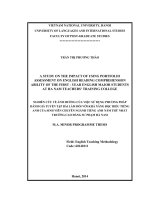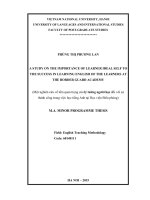Luận văn thạc sĩ VNU ULIS a study on how scriptwriters flout certain maxims of grices cooperative principle to create verbal irony through the sitcom friends from episode 1 to episode 10
Bạn đang xem bản rút gọn của tài liệu. Xem và tải ngay bản đầy đủ của tài liệu tại đây (172.53 KB, 5 trang )
VIETNAM NATIONAL UNIVERSITY, HANOI
UNIVERSITY OF LANGUAGES AND INTERNATIONAL STUDIES
FACULTY OF POST-GRADUATE PROGRAM
ĐÀO THỊ VÂN HỒNG
A STUDY ON HOW SCRIPTWRITERS FLOUT CERTAIN
MAXIMS OF GRICE’S COOPERATIVE PRINCIPLE TO
CREATE VERBAL IRONY THROUGH THE SITCOM
“FRIENDS” FROM EPISODE 1 TO EPISODE 10.
(NGHIÊN CỨU VIỆC CHỦ Ý VI PHẠM MỘT SỐ PHƯƠNG CHÂM HỘI
THOẠI TRONG NGUYÊN TẮC HỢP TÁC CỦA GRICE ĐỂ TẠO NÊN
TÍNH MỈA MAI QUA KỊCH BẢN CỦA LOẠT HÀI KỊCH TÌNH HUỐNG
“FRIENDS” TỪ HỒI 1 ĐẾN HỒI 10).
M.A. THESIS (COMBINED WORK)
Field: Linguistics
Code: 60 2215
Hanoi - 2010
LUAN VAN CHAT LUONG download : add
VIETNAM NATIONAL UNIVERSITY, HANOI
UNIVERSITY OF LANGUAGES AND INTERNATIONAL STUDIES
FACULTY OF POST-GRADUATE PROGRAM
ĐÀO THỊ VÂN HỒNG
A STUDY ON HOW SCRIPTWRITERS FLOUT CERTAIN
MAXIMS OF GRICE’S COOPERATIVE PRINCIPLE TO
CREATE VERBAL IRONY THROUGH THE SITCOM
“FRIENDS” FROM EPISODE 1 TO EPISODE 10.
(NGHIÊN CỨU VIỆC CHỦ Ý VI PHẠM MỘT SỐ PHƯƠNG CHÂM HỘI
THOẠI TRONG NGUYÊN TẮC HỢP TÁC CỦA GRICE ĐỂ TẠO NÊN
TÍNH MỈA MAI QUA KỊCH BẢN CỦA LOẠT HÀI KỊCH TÌNH HUỐNG
“FRIENDS” TỪ HỒI 1 ĐẾN HỒI 10).
M.A. THESIS (COMBINED WORK)
Field: Linguistics
Code: 60 2215
Supervisor: Dr. Assoc. Prof. Trần Xuân Điệp
Hanoi - 2010
LUAN VAN CHAT LUONG download : add
5
TABLE OF CONTENT
PART 1: INTRODUCTION ................................................................................................ 1
1.1. Rationale ....................................................................................................................... 1
1.2. Aims of the study ........................................................................................................... 2
1.3. Research questions ....................................................................................................... 2
1.4. Significance of the study ................................................................................................ 2
1.4.1. In theory ...................................................................................................................... 2
1.4.2. In practice .................................................................................................................... 3
1.5. Scope of the study .......................................................................................................... 3
1.6. Design of the study ........................................................................................................ 4
PART 2: THE DEVELOPMENT ....................................................................................... 5
CHAPTER 1: THEORETICAL BACKGROUND ............................................................ 5
1.1. Implicature .................................................................................................................... 5
1.1.1. Definition of implicature ............................................................................................. 5
1.1.2. Implicature and inference ........................................................................................... 6
1.1.3. Types of implicature .................................................................................................... 7
1.2. Grice’s cooperative principle ....................................................................................... 8
1.2.1. Conversational maxims ............................................................................................... 8
1.2.1.1. The maxim of quality.................................................................................................. 8
1.2.1.2. The maxim of quantity ................................................................................................ 9
1.2.1.3. The maxim of relation .............................................................................................. 10
1.2.1.4. The maxim of manner............................................................................................... 10
1.2.2. Observing the maxims................................................................................................ 11
1.2.3. Non-observances of the maxims ................................................................................ 11
1.2.3.1. Flouting a maxim .................................................................................................... 12
1.2.3.2. Violating a maxim ................................................................................................... 12
1.2.3.3. Infringing a maxim .................................................................................................. 13
1.2.3.4. Opting out of a maxim ............................................................................................. 13
1.2.3.5. Suspending a maxim ............................................................................................... 14
1.2.4. Flouts exploiting the maxims .................................................................................... 15
LUAN VAN CHAT LUONG download : add
6
1.2.4.1. Flouts exploiting the maxim of quality...................................................................... 15
1.2.4.2. Flouts exploiting the maxim of quantity ................................................................... 16
1.2.4.3. Flouts exploiting the maxim of relevance ................................................................ 16
1.2.4.4. Flouts exploiting the maxim of manner .................................................................... 17
1.3. Irony ............................................................................................................................ 19
1.3.1. Ironology: A history of irony ..................................................................................... 19
1.3.2. Definition of irony ..................................................................................................... 20
1.3.3. Taxonomy of irony ..................................................................................................... 22
1.3.4. The risks and rewards of ironic communication ........................................................ 24
1.3.4.1. The risks of ironic communication ........................................................................... 24
1.3.4.2. The rewards of ironic communication ...................................................................... 26
1.3.5. Self-directed irony ..................................................................................................... 27
CHAPTER 2: THE STUDY ................................................................................................. 29
2.1. Methodology ............................................................................................................... 29
2.1.1. Qualitative and quantitative methods ........................................................................ 29
2.1.2. Some supplementary techniques ............................................................................... 30
2.2. An introduction to American sitcoms and the sitcom “Friends” .............................. 30
2.2.1. Definition of sitcoms ................................................................................................. 30
2.2.2. Characteristics of American sitcoms ......................................................................... 31
2.2.2.1. Common characteristics of sitcoms .......................................................................... 31
2.2.2.2. Characteristics of American sitcoms ........................................................................ 32
2.2.3. The sitcom “Friends” ................................................................................................ 33
2.2.3.1. Main characters ....................................................................................................... 33
2.2.3.2. First season sypnose ............................................................................................... 34
2.3. Findings and discussion ............................................................................................... 35
2.3.1. Findings .................................................................................................................... 35
2.3.1.1. The analysis on situations which flout the maxim of quality ..................................... 36
2.3.1.2. The analysis on situations which flout the maxim of quantity ................................... 49
2.3.1.3. The analysis on situations which flout the maxim of relation ................................... 54
2.3.1.4. The analysis on situations which flout the maxim of manner .................................... 60
2.3.2. Discussion ................................................................................................................. 65
LUAN VAN CHAT LUONG download : add
7
PART 3: THE CONCLUSION .......................................................................................... 68
3.1. Recapitulation of main ideas ...................................................................................... 68
3.2. Limitations of the study .............................................................................................. 69
3.3. Suggestions for further research ................................................................................ 69
Appendix
LUAN VAN CHAT LUONG download : add









